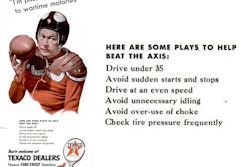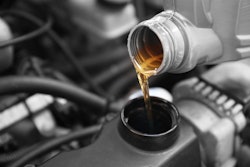You may remember that we covered coolant last month, specifically how topping coolant off all winter can throw your system out of balance when the weather turns warmer, limiting your coolant system’s ability to actually cool. We’re talking coolants again this week, but this time how to know when you’ve got a problem.
Contents of this video
00:00 10-44 intro
00:28 Testing your coolant
01:51 Identifying cooling system problems
04:17 Instruments for testing coolant
05:08 Refractometers
06:49 Visual checks
08:12 Using test strips
10:47 pH balance of coolant
Jason Cannon:
CCJ's 10-44 is brought to you by Chevron Delo heavy duty diesel engine oil. Now there's even more reasons to choose Delo.
We're talking coolants again this week, but this time how to know when you've got a problem. You're watching CCJ's 10-44, a weekly webisode that brings you the latest trucking industry news and updates from the editors of CCJ. Don't forget to subscribe and hit the bell for notifications so you'll never miss an installment of 10-44.
Hey, everybody. Welcome back. I'm Jason Cannon and my co-host on the other side is Matt Cole. You may remember we covered coolants last month, specifically how topping off coolant all winter can throw your system out of balance when the weather turns warmer and limit your coolant system's ability to actually cool itself. This week we're talking about testing your coolant, not just for balance, but also to make sure other areas of maintenance aren't falling apart all around you.
Matt Cole:
A coolant test sounds pretty simple. You put the floating ball tool in the sump, give it a squeeze and making any necessary adjustment. But Chevron Lubricants commercial fleets business consultant, Shelly Eckert, who joins us again this week says there's a lot more to it. And if you're a user of that floating ball tool, you really need to stick around.
Shelly Eckert:
What I like to do with my fleets is have them test every single time that truck is in the shop because they can test using field test equipment, right? Test strips, a refractometer while that truck is still in the bay, and then they'll know right away that they need to do something before that driver pulls out of that bay. If the test strips and the refractometer, and we'll talk about this, are not showing what the problem is, then that's when I would recommend taking a sample and sending it to the lab. But the difference is that you're talking, taking a sample, sending it into lab, you've got transit time, then you have the testing time, and then you got to get the report back to you, which is typically now online or via email, but you're talking about a week.
Jason Cannon:
So your coolant test shows that something's out of whack. Maybe it's so out of compliance that you should just flush it and start over. Well, not so fast. Just fixing that problem might not be the fix to your real problem.
Shelly Eckert:
What that cooling system is going to tell you that there's other things going on, such as if you have a cracked EGR, then the gas from the EGR will get into the cooling system and make it acidic. So if you drop flush that coolant out, that's not going to solve that EGR problem. It'll just start the whole problem all over again, and then you're just flushing money down the drain.
Matt Cole:
You've heard Shelly mention a refractometer and test strips a few times already. What you haven't heard her say is floating ball tool, which is really called a hydrometer. There's a reason for that, and she tells us what that reason is after a quick word from 10-44's sponsor, Chevron Lubricants.
Speaker 4:
These past few years have been less than easy. We've encountered challenges we never imagined we'd ever have to deal with, from makeshift home offices and video meetings to global supply chain uncertainty, price instability, market disruptions, and everything in between. Delivering the level of services and products our customers had come to expect was difficult for all of us. We can't change what's behind us, but we can definitely learn from it. We can adapt, evolve, and take steps to reset our thinking, adapt our strategies, and restore your trust in us to better meet your needs now, and in the future.
That change begins today. Today we break with convention and introduce a rebalanced line of Delo heavy duty engine oils. We've reduced our product line from four categories to two. Consolidated and simplified, this lineup removes complexity from the manufacturing processes, enhancing price stability and supply chain reliability so you can trust you will have the premium products you need to keep your business always moving forward.
Our break with convention optimizes the Delo lineup to allow you to provide your customers with the best synthetic blend and synthetic heavy duty engine oils in the market, fully available at prices you can rely on. It's your assurance that you'll be well positioned to be their trusted source for proven engine protection that keeps equipment on the job, giving your customers even more reasons to choose Delo.
Shelly Eckert:
What happens with a hydrometer, when you get oil into the coolant and you get that layer of coolant, when you go in and suck up the coolant to test the freeze point, oil will come with it and then it gets on the balls of that floating hydrometer and it causes that hydrometer not to read correctly, and then over time it just gets worse.
A great example, I was in the shop one time and the guys, I said, "How are you testing your freeze points?" And every single one of them showed a different hydrometer, and I said, "Okay, great. Let's use this truck over here and we'll all take a freeze point and we'll compare what we get for results." The brand new one was the closest one. The other three were different from each other. That's why I don't recommend them. They're just not trustworthy.
Jason Cannon:
Shelly prefers that fleets use a refractometer because it's more reliable and it's relatively inexpensive. Your oil and coolant supplier should be able to get you one, but I found a bunch of them on Amazon for about $20.
Shelly Eckert:
And the other reason why I like to use a refractometer is because that's what the lab is using. Same instrument, which I happen to have one with me. Right? So simple to use. You just raise the shield, put a couple of coolant drops on it, drop it down, go to a light source, and you can read the scale inside of it. Some of the scales are different. Some will even test the DEF now at the same time or using the same refractometer. Typically, I see two different refractometers, but there is one that has the DEF in there. Ethylene glycol, propylene glycol.
First thing you need to know is are you testing ethylene glycol or propylene glycol? Typically, in the trucking world, you're going to see the ethylene glycol. Where you see propylene glycol is typically food industry or if circulating in the truck where it could come possibly into contact with food. It's not as toxic as ethylene glycol is.
The best way to make sure that this is reading correctly is you just put on room temperature water, because water, no matter where it comes from, freezes at 32 degrees and then there's a water line inside of here. If it's not right there on that water line, you just take this off and there's a little adjusting knob in here that you just adjust the line up and down to make sure that it's right there on the water line. So if that's not accurate, then when you start reading the freeze point, that's not going to be accurate, right?
Matt Cole:
Want an even cheaper analysis tool? Shelly says, just use your eyes.
Shelly Eckert:
Make sure it's not hazy or cloudy or has any sediment residue in it. One way you can do that is take a quick look from the outside of the sump, but some of these dyes are so strong in these coolants that it can leach into the cooling system or flow tank, and it can cause what appears to be one coolant to look like that. So you actually have to get into the cooling system and take a sample out.
Things you can use is a turkey baster from Walmart, you can use a pipette, and then I would use a clear container. This is a little beaker, but you can get plastic bottles anywhere, Walmart, Michaels, arts and crafts, you can get them anywhere and then just squirt it in visually take a look at it, right? And that also gives you a confirmation of exactly what color is in that cooling system, but I like to repeat, color of the coolant means nothing. It's just dye. So you have to know what you're starting with for the coolant in the cooling system, and typically when it's factory-filled, it'll have a decal on there explaining if it's an OAT, a NOAT, a HOAT, or now a new coolant on the market, a POAT, which is a phosphate organic acid technology.
Jason Cannon:
Now, you knew we would eventually get to the chemistry heavy portion of this study guide, and it's a good thing we have somebody smart like Shelly to walk us through it because testing strips are really an important part of cooling analysis. But what good is a test strip if you don't know what's in the sump and what that pH should be?
Shelly Eckert:
That pH test strip, which I have them here somewhere, is a scale of zero to 14. Okay? Each one has different colors on it. It's measuring different pHs. Typically, you're targeting for an extended life coolant an eight. Test strips are different, but a lot of these are very commonly found. You also can get these on Amazon, just like a refractometer. You can get that on Amazon too. An eight is typically what you see for an extended life coolant. If you're more into the conventional or fully formulated, you're going to be more like a 10 or 11.
Now, if you're supposed to be on extended life coolant and all of a sudden your pH is reading 10 or 11, that means you're probably getting nitrates in the system. It's raising the pH. That could be from somebody pouring in fully formulated conventional coolant, or somebody that's still using a pre-charged SCA filter, DCA filter, or somebody who's poured in liquid SCAs or DCAs thinking they were doing the right thing by re-additizing the extended life coolant, and that's not the right thing to do.
If it's less than seven, that means the coolant has become acidic. That's when you start looking for head gasket leaks or the EGR leaks getting into the coolant. When it drops below seven, the best course of action is to drop the coolant. So for example, going back to this refractometer, it goes hand in hand with the pH. So if you have to adjust your coolant because the freeze point is off, whether that's high or low, which I can talk about in a second, test that pH first. If that pH fails, you're just going to drop it anyway, so why bother taking the time to adjust the coolant?
So as the coolant ages, nitrates will deplete. That's why when you're dealing with a nitrate organic acid, you have to find a way to get nitrates back in and monitor those nitrates, which is why there's nitrate test strips on the market too, to monitor the nitrates. But again, if you're looking at that pH and you know you're supposed to be on an extended life coolant, and it bounces to 10 or 11, that's telling you you typically have nitrates and the wrong coolant is going in there or something on the coolant adds.
Matt Cole:
The pH of the coolant is consistent, or it should be unless something is happening to the system itself. When your test strips show your pH is off, that's a clear indicator of a problem.
Shelly Eckert:
So when you start with a glycol, it's going to be an eight. You add water to it and you cut it in half, it's still going to be an eight for typical extended life coolants. Another example would be the typical coolant on the market is 50/50, but if you are up north or you're doing like a... Knowing that a unit for factory fill is going to go up into Canada or Russia or Siberia, you're going to have maybe a 55/45 mix coming out of the factory. Could be a 60/40, or it could be a 40/60 depending on where that unit's going to go.
So again, knowing what you're at, right? But no matter all those different mix combinations or cutting of the water, that pH is going to be the same unless something is happening to that cooling system. And when in doubt, take a sample, send it into the lab, and they can give you a battery of tests results that will tell you exactly what that coolant is. But that's time and money, and sometimes that's just a matter of draining and flushing and starting over.
Jason Cannon:
That's it for this week's 10-44. You can read more on ccjdigital.com. While you're there, sign up for our newsletter and stay up to date on the latest in trucking industry news and trends. If you have any questions or feedback, please let us know in the comments below. Don't forget to subscribe and hit the bell for notifications so you can catch us again next week.










